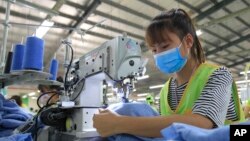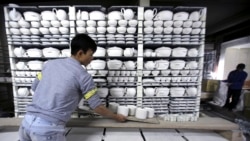Vietnam’s government is seeking to expand the country’s economy by seven percent this year. The goal would be one of Vietnam’s highest growth rates yet and could be greater than China’s expected economic expansion in 2020.
The Vietnam-based financial services company SSI Research reported the goal on January third. The Vietnamese central government set a target for its Gross Domestic Product, or GDP, to increase 6.8 to seven percent. GDP represents the value of all goods and services produced within a country during one year.
SSI Research said the growth is expected to be driven by investments in manufacturing, a lack of trade disputes involving Vietnam and a rising middle class. Manufacturing is predicted to be the leading area of growth, followed closely by the service industry, SSI Research said.
The Asian Development Bank keeps economic data of Asian countries. Its information shows that a seven percent expansion rate would place Vietnam among the 10 fastest-growing Asian economies this year. It also would put Vietnam ahead of China. The development bank has predicted a six percent rate for China in 2020.
Song Seng Wun is an economist with CIMB, a banking group in Singapore. He told VOA that much of Vietnam’s predicted growth in 2020 will come from money flowing into factories, offices and port operations.
Experts say foreign-supported manufacturing is expected to lead the country’s economy in 2020, just as it has for the past seven years. Song said a lot of foreign investors like, what he calls, “government stability” in Vietnam. Pay for factory workers in Vietnam can also be low. They can receive as little as $132 a month.
Most of the investors come from Japan, Singapore, South Korea and Taiwan. The companies’ Vietnamese factories produce things like clothing, car parts and electronics.
In the first half of 2019, foreign investment projects were expected to reach $9.1 billion. That would be a nearly eight percent increase over the same period in 2018. That information comes from the website of the Ministry of Planning and Investment.
Besides manufacturing, economic experts say tourism and improvements in higher education are also expected to increase growth.
Between 2010 and 2018, the number of foreign tourists in Vietnam increased from 5 million to more than 15 million. This growth was mainly fueled by an increase in Chinese visitors.
Economists say another driver of foreign investment in Vietnam is a rise in higher education enrollment. The percentage of Vietnamese receiving higher education has jumped from 10 to about 30 percent of the population since 2000.
Murray Hiebert is a Southeast Asia expert at the Center for Strategic and International Studies in Washington, D.C. He told VOA that education matters in Vietnam because investors want workers with stronger problem-solving skills. Such employees can work in technical positions or help lead local offices, Hiebert said.
The Boston Consulting Group predicts that more than one-third of Vietnam’s 97 million people will be in, what is considered, the middle class by next year. Middle-class growth is fueled mainly by jobs created by manufacturing for export. As a result, many Vietnamese now have more money to spend on things like electronics, transportation, travel and education, the group said.
I’m Bryan Lynn.
Ralph Jennings reported this story for VOA News. Bryan Lynn adapted the report for Learning English. Mario Ritter, Jr. was the editor.
We want to hear from you. Write to us in the Comments section, and visit our Facebook page.
________________________________________________________________
Words in This Story
stability – n. the state of not being likely to change or move
tourism – n. the business of providing services for visitors to a place
enrollment – n. to become an official member of a college or university










